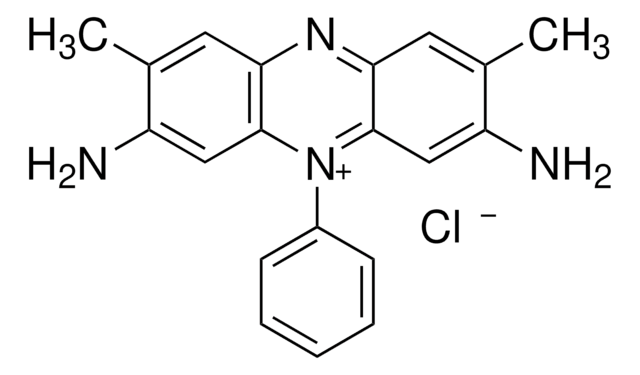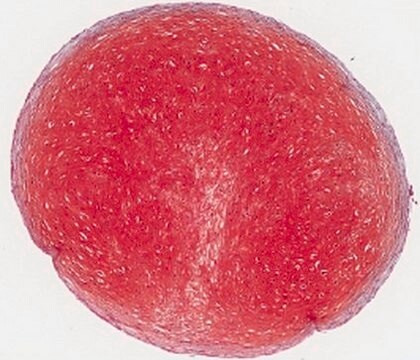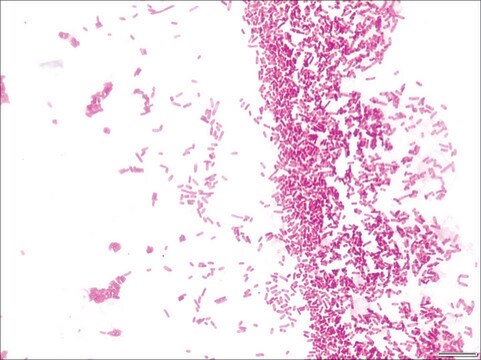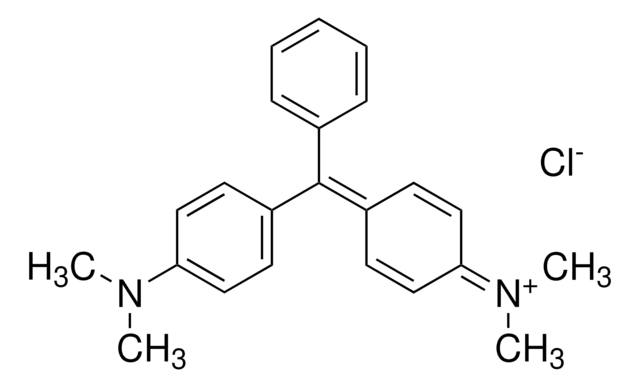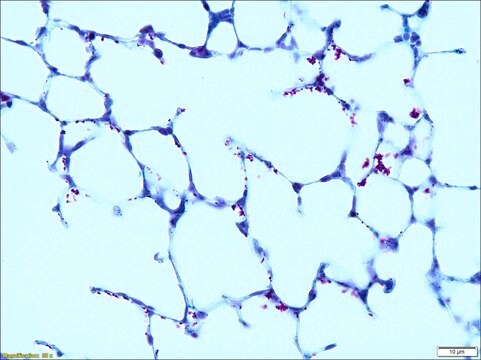84120
Safranine O
for microscopy (Bact., Bot., Hist.), indicator (pH 0.3-1.0)
Synonyme(s) :
Basic Red 2, Cotton Red, Gossypimine, Safranine T, Safranine Y ou A
About This Item
Produits recommandés
Qualité
for microscopy (Bact., Bot., Hist.)
indicator (pH 0.3-1.0)
Niveau de qualité
Forme
powder or crystals
Technique(s)
titration: suitable
pH
10 (20 °C, 10 g/L)
Solubilité
methanol: 0.01 g/10 mL, red
εmax
≥1000 at 525-535 nm in 50% ethanol
Application(s)
diagnostic assay manufacturing
hematology
histology
microbiology
Température de stockage
room temp
Chaîne SMILES
[Cl-].Cc1cc2nc3cc(C)c(N)cc3[n+](-c4ccccc4)c2cc1N
InChI
1S/C20H18N4.ClH/c1-12-8-17-19(10-15(12)21)24(14-6-4-3-5-7-14)20-11-16(22)13(2)9-18(20)23-17;/h3-11H,1-2H3,(H3,21,22);1H
Clé InChI
OARRHUQTFTUEOS-UHFFFAOYSA-N
Vous recherchez des produits similaires ? Visite Guide de comparaison des produits
Description générale
Application
- Safranin O is widely employed as a microbiological stain, especially as a counterstain in Gram staining to distinguish Gram-positive from Gram-negative micro-organisms, and for staining bacterial spores.
- It is used to demonstrate glycosaminoglycans in human and animal histological specimens and nuclei.
- It is a component of Benda′s polychrome stain.
- It is a component of various polychromes and lignin stains for botanical staining applications.
- It has also been applied for the demonstration of mast cells in cytospin preparations and staining surgical frozen sections.
Mention d'avertissement
Danger
Mentions de danger
Conseils de prudence
Classification des risques
Eye Dam. 1
Code de la classe de stockage
11 - Combustible Solids
Classe de danger pour l'eau (WGK)
WGK 3
Équipement de protection individuelle
dust mask type N95 (US), Eyeshields, Gloves
Certificats d'analyse (COA)
Recherchez un Certificats d'analyse (COA) en saisissant le numéro de lot du produit. Les numéros de lot figurent sur l'étiquette du produit après les mots "Lot" ou "Batch".
Déjà en possession de ce produit ?
Retrouvez la documentation relative aux produits que vous avez récemment achetés dans la Bibliothèque de documents.
Les clients ont également consulté
Notre équipe de scientifiques dispose d'une expérience dans tous les secteurs de la recherche, notamment en sciences de la vie, science des matériaux, synthèse chimique, chromatographie, analyse et dans de nombreux autres domaines..
Contacter notre Service technique